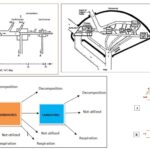rolling circle model of dna replication
rolling circle model of dna replication
Please login to submit an answer.
Initiation of Replication
The process begins when an initiator protein binds to the origin of replication on the circular DNA molecule.
This protein introduces a single-strand nick at a specific site, creating a 3′ hydroxyl group and a 5′ phosphate group.
The 3′ end serves as a primer for DNA synthesis, while the 5′ end is displaced and remains bound to the initiator protein.
Elongation of the Leading Strand
DNA polymerase III attaches to the 3′ end of the nicked strand and begins synthesizing the new DNA strand in the 5′ to 3′ direction.
The original, uncut strand acts as the template for this continuous synthesis.
As replication progresses, the newly synthesized strand displaces the original strand, forming a single-stranded DNA (ssDNA) molecule.
Formation of Concatemers
The continuous replication around the circular DNA template results in the production of concatemeric DNA.
A concatemer is a long, linear DNA molecule consisting of multiple linked copies of the original genome.
These concatemers can be several kilobases in length and are often cleaved into unit-length genomes for packaging into new virions.
Termination and Circularization
Replication continues until a termination signal is encountered, at which point the initiator protein makes another nick to release the newly synthesized strand.
The free 3′ end of the released strand serves as a primer for the synthesis of a complementary strand, converting the ssDNA into double-stranded DNA (dsDNA).
DNA polymerase I removes any RNA primers, replacing them with DNA nucleotides, and DNA ligase seals the nicks, resulting in a complete circular dsDNA molecule.
Check this note –
Rolling Circle Replication – Mechanism, Application
- Share on Facebook
- Share on Twitter
- Share on LinkedIn
Helpful: 0%




